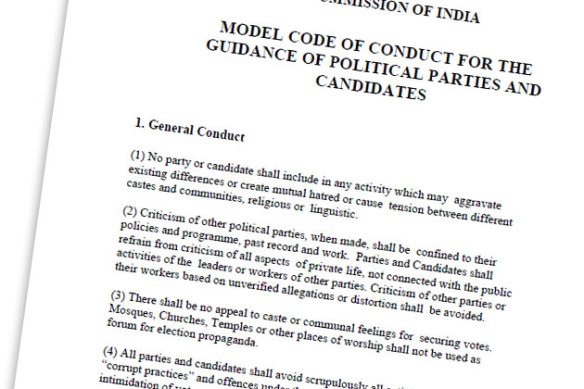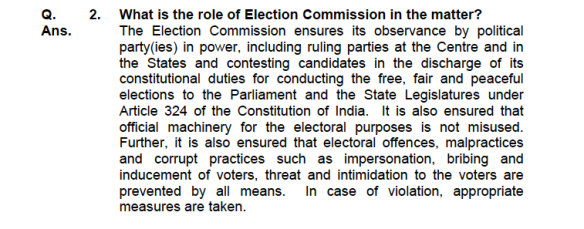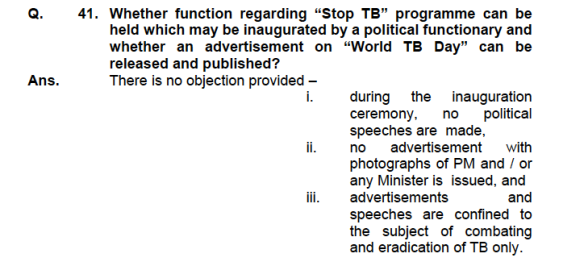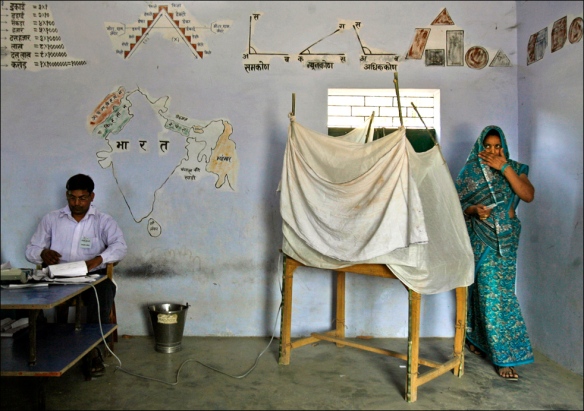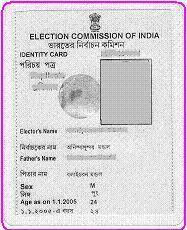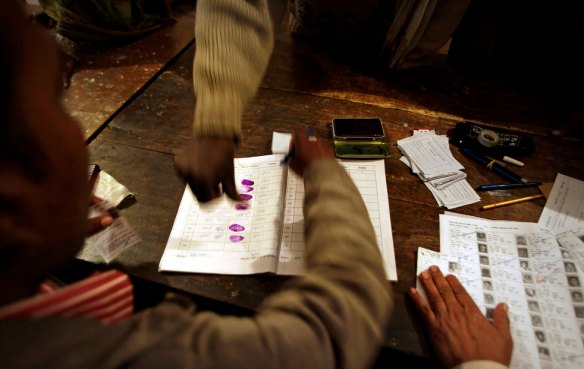This is the final post thinking about an important recent lecture given by the former Chief Election Commissioner of India, S. Y. Qureshi, at the Center for South Asia Studies at the University of California, Berkeley. A first post focused on what I termed narratives and practices of heroic inclusion; a second on the experimental transformation of the EPIC voter identification system into a biometric database, and the resulting conflicts between government agencies over their own administrative data preserves. The general point is to think about the range of sites where specific registers of “inclusion” operates as a dominant mode of governance, about the sites of conflict between modes of inclusion, and about the forms of lives and worlds and politics that come into being around these particular modes.
The Chief Election Commissioner talked at some length about the Model Code of Conduct, and so I want to follow his lead and think carefully about this “model code” in relation to law.
What is a model code of conduct? The term raises legal questions I will defer for now but will want to return to. Here I look at sections of the 2007 Model Code of the Electoral Commission.
At the outset, I want to think about several points made in the lecture:
(1) the Model Code is not statutory: it is not, that is, a body of law. It lacks the force of law. And, presumably, it lacks the checks and balances put in place in and with the law. Or put conversely, it has the power of a body of law-like codes, norms, and practices that are effective precisely in the exceptional condition of being outside the law.
I think here of the work of many scholars, including Laura Nader on mediation in the US and Katherine Lemons on a range of law-like forms of marital and religious judgment and counseling in India that stand outside the formal apparatus of Personal Law. I think also of the UIDAI itself: the debate over it, particularly when administrative preserves of data and control over these are at stake, is of course that it, too, lacks statutory authority: that Universal ID as a form of governance is not grounded in law, or only barely, depending on who and what one reads.
So my interest, in part, lies in the formal congruities (and their limits) between the EC and UID as exceptional apparatuses of inclusion through identification and information capture.
(2) The model code is powerful in its promotion of order: Dr. Qureshi offered multiple examples of how the EC and it’s code were able to trump the usual “nexus” of politicians, parties, police, and what in India are often termed “vested interests.” He spoke again and again of the importance of “order” in providing fair and accessible democracy. He referred to a critic of the model code’s many rules forbidding posters, loudspeakers, and other advertisements for a candidate near a polling station, who he said complained that the EC had taken “the carnival” out of democracy. He responded, he told the audience, that he would be happy to bring the carnival over to her home and to see how she then felt.
The form here is reminiscent, again, of debates over privacy and UID. UID is charged with violated privacy rights: its defenders and architects suggest that such concerns are elitist and that the aam aadmi, the ordinary person, cares about food, shelter, and clothing. The elite critic who presumably lives in a sheltered environment can easily call for the carnivalesque: the stakes for those who strive for non-existent order are otherwise. The point, again, is not to accede to this claim but to attend to the ubiquity of the form.
The idea of a firm order outside of law that guarantees the law is suggestive of a series of debates in political theory about sovereignty leading from Carl Schmidt to Hannah Arendt to Giorgio Agamben. If sovereign is he [sic] who wields the exception, if the sovereign can kill without that death being either a crime (negative value) or a sacrifice (positive value), then the conception of a sovereign entails a form of life that can be ended as if it carried none of the distinguishing qualities of human life within a legal, ethical, and civil frame, as if it were just “bare life.” For Agamben, in a formulation that would later be carefully qualified, a classical conception of the sovereign demanded a distinctive “zone of indistinction” in which the difference between civil life (that cannot be killed without it being a sacrifice or crime) and bare life (that can be killed without what I am terming a shift in value) could not be maintained. Famously, Agamben would reread Foucault’s concept of biopolitics as a radical enlargement of the zone of indistinction between civil and bare life in the figure of the statistically established population.
This last paragraph is a quick rehash: the point is to open up thinking about what kind of exception the model code might entail, and to what extent if any it addresses “life” in ways relevant to this line of thinking. What is intriguing about the EC is its own standing in some kind of legal exception. The model code of conduct emerges as more powerful, in the time of elections, than the nexus of interests itself, the latter ever threatening to deform civil society: it emerges as the sole bulwark against the nexus. And yet the model code, guaranteeing law (and, as the Chief Election Commissioner repeatedly noted, “order,” stands in arguable exception to the rule of law, lacking as he noted firm statutory authority. As I noted above, the form of the exception is repeated, perhaps, in the often debated status of UIDAI as lacking statutory authority. But whereas the EC is celebrated as the bulwark of democratic norms set agains the ever present threat of the nexus, and the forces of disorder that this ubiquitous figure invokes, the UID troubles and affirms in equal measure, depending on the interlocutor.
The Idea of a Model
What may be important is the general form of a “model” code, in and around law and specifically in and around the law of India. Caught in the moment of ignorance (the general modus operandi of this blog as it lurches from topic to topic), let me reflect for now on the temporal register, in general, of a model as coming after a pre-existing form (as in a scale model of something, say a ship or the Taj Mahal) or before, anticipating and preparing for a possibility (as in the modeling that plans for structures and events). The dominant register of the model code is the latter: the code serves as the model for a democratic practice it anticipates and (re)forms. But it may, in a particularly (and familiar) post-colonial idiom, evoke an imagined order of colonial liberal governance as a rationalized system of order ever keeping the nexus at bay.
Models also, as the figure of the ‘scale model’ above illustrates, play with the scale of the gigantic and miniature. I am not sure how to think with this feature of modeling, save that the lecture that this blog draws from kept moving from enormity (India itself, and the realized demand for the inclusion of its “mass” population) to minuteness (the single voter in a far-off jungle reserve, or the tiny outpost in the Himalayan vastness).
The Model Code Itself
Let me close with a few sections of the code, with brief notes.
The primary actor here is the Party and then the Candidate. What is at stake here is a grammar of the nexus.
Impersonation is a particular form of duplication; intimidation acts on the original. If the EC sees its exceptional powers as operating on both registers, UIDAI arguably focuses on the former, as technically remediable, and evades the latter.
I conclude with this Question and Answer within the FAQ section that is far longer than the formal Model Code itself. Can an administration, ruled by a particular Party running for office during an election, hold an event designed to save or preserve mass life? Here the question is in regards to tuberculosis. These sorts of questions appear regularly during election seasons, and the reportage holds open a tension between a political system that is thanatopolitical–that is, that does nothing effective to address the mass morbidity of a governed population for most of the non-electoral season–and an EC that is overstepping its commitment to its Code–that is, that would prevent a life-saving event in the name of abstract norms that do not take into account the precarious life of most citizens.

